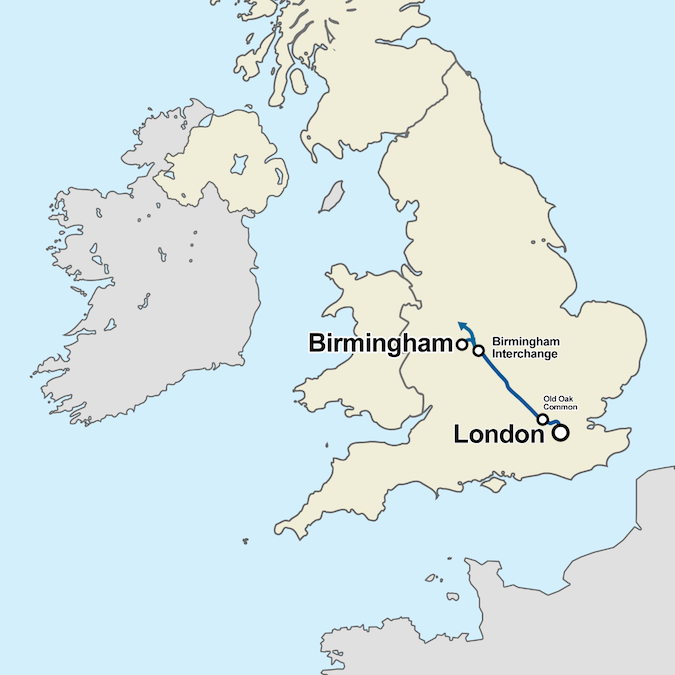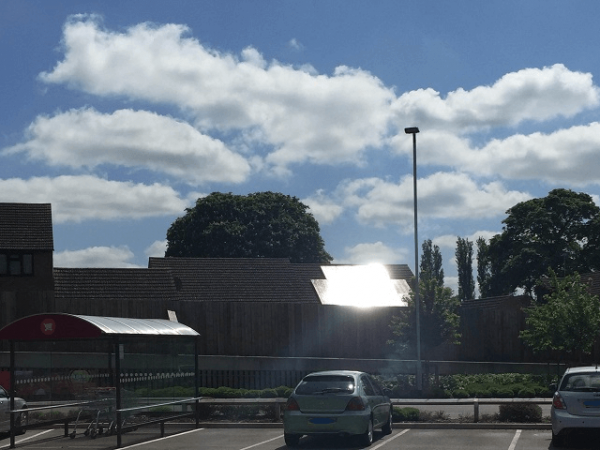In the 3rd article in our series on the Baltic States, we take a look at a prominent high-speed rail development called Rail Baltica and compare this to the UK’s own high-speed rail development High Speed Rail 2 (HS2). Rail Baltica is a joint Estonian, Latvian, Lithuanian, and European Union-led, cross-border high-speed rail development.
Figure 1: Rail Baltica as Part of the North Sea-Baltic Core Network Corridor [1].
High Speed Rail 2 (HS2) – A UK Failure?
In the UK we are very familiar with high-speed rail developments re-occurring in the news. High Speed Rail 2 (HS2) the long-awaited, enormously expensive, and technologically outdated high-speed railway development has been an infamous project of international embarrassment – one might argue.
High-Speed Rail 2 (HS2) is a UK government project to build a high-speed railway linking London to Birmingham and previously to the North of England including Manchester. Recently, Rishi Sunak, Prime Minister of the UK, has said that ‘The facts have changed’ regarding HS2 and confirmed that the originally planned link between Birmingham and Manchester would be scrapped with the London to Birmingham link remaining as planned.
Rishi Sunak did not hold back in his criticisms of HS2 when announcing an alternative plan called Network North, for the £36 billion that would have been used on the scrapped Birmingham to Manchester HS2 link, ‘…A scheme whose own economic case shows that almost half the benefits go to London and the South East. And the facts around HS2 have changed. Costs have more than doubled. It has been repeatedly delayed. The pandemic has significantly changed the travel patterns it was originally designed to serve. In short, HS2 traps enormous sums of money that could be far better spent elsewhere.’ In recent news, an HS2 boss has admitted that the cost, for the remaining link between London and Birmingham, could continue to spiral upwards to the hefty sum of £66 billion. Network North is a plan that predominately shifts the focus from rail to roads, local transport, and a focus on economic benefits towards the North of the UK as opposed to the primary beneficiaries of HS2 being the South of the UK and London.
Figure 2: High-Speed Rail 2 in the UK [2].
Rail Baltica – High-Speed Rail Done Right?
Rail Baltica is a continuous railway network from Tallinn, Estonia to Warsaw, Poland. The total length [3] of the sections of railway lines in the Baltic States is 870km. The cost of Rail Baltica is expected to be €5.8 billion [4], this figure is up from an initial cost estimate of €3.6 billion [5]. Funding for Rail Baltica is as follows: Estonia € 235 million; Latvia €303 million; Lithuania € 286 million; and co-funding from the EU for up to 85% of the costs [6]. The cost of Rail Balatica works out to €6.67 million per kilometre. In contrast, the cost per kilometre for HS2 in the UK is potentially as high as €345 million per kilometre [7], approximately 52 times the cost per kilometre. Part of this cost disparity is naturally affected by the economic differences between the UK and the Baltic States. The GDP per capita for the UK [8] is $46,125 whereas in Estonia [9] for example this is $28,247. The two rail networks also differ in terms of how high speed they are. HS2 trains will run at speeds of up to 360 km/h with routine speeds at up to 330km/h [10]. In contrast, Rail Baltica is equipped for speeds of up to 249 km/h and will run at operational speeds of up to 234 km/h and freight trains at up to 120 km/h. However, it is worth noting that in France, which has a similar GDP per capita to that of the UK, similar rail projects cost €33.44 million per kilometre [11]. Therefore, why else is HS2 so expensive when compared to Rail Baltica and other significant railway infrastructure projects? Some of the potential reasons are listed below.
- HS2 can accommodate 18 trains per hour, which is more than any other railway network in the world [12].
- Ground conditions were worse than had initially been expected, requiring more structural work before laying railway tracks [13].
- The cost of purchasing land and property through which HS2 cuts through. ‘The initial stretch from London Euston to Old Oak Common in west London will be through a giant tunnel underneath central London…compulsorily purchase land and property rights along the route, and a block of flats in London doesn’t come cheap’. [14]
- The UK is much more densely populated with existing roads, bridges, and rivers needing to be diverted. ‘On the M42 near Solihull they have been building the foundations for a new bridge over the motorway…on Spain’s high-speed AVE network, which flies through large stretches of desolate, arid countryside.’ [15]
Can Rail Baltica Boost the Baltic States Economies?
With regard to infrastructure projects in the Baltic States there is a focus on greater integration with the EU for example the harmony link, an electricity interconnector to the EU, and a prominent cross-border offshore wind development ELWIND.
The offshore wind capacity of the Baltic States is significant with Latvia’s offshore wind energy potential alone being approximately 15 GW [16] and far beyond the current demands of the Baltic States. A big question remains as to where will all of this energy be exported to and how. Well, the question of where is rather clear given the existing geopolitical environment with the ongoing Ukraine-Russia war. The Baltic states are very much directing their attention to exporting energy to the EU. However, the current capacity of the electricity grid in the Baltic States will require significant upgrades to export this energy. Rail Baltica may naturally act as a catalyst for energy grid upgrades to run alongside as one holistic project, but this remains to be seen. Likewise, Rail Baltica isn’t just a passenger rail network, it will also support the transport of goods via freight trains and it may also provide a means of transporting stored energy in the form of hydrogen. Rail Baltica will also naturally assist with the transportation of equipment that will be needed for other infrastructure projects in the Baltic States.
Conclusions
The future for long-term investment and economic growth in the Baltic States is looking bright. This is partly eased by the clean slate with which the landscape offers given the low density population. This has the advantage of bringing down costs whilst the UK is bogged down by cutting through existing infrastructure, the expense of highly paid experts, and frequent changes to government strategy that hinder long-term investment. As the Baltic states continue on a fast journey to further integration with Europe, the UK heads straight to Platform 9¾ with a bang, rather confused as to why it continues to remain stationary. For Rail Baltic, let’s hope that the ‘facts don’t change’ as the Baltic Nations potentially show the UK what High-Speed Rail looks like when done right.
Pager Power
Pager Power has worked on glint and glare assessments with respect to railway operations and infrastructure in the UK and internationally. Pager Power is a dedicated technical consultancy that has been providing independent guidance and advice regarding solar developments, wind farms, and building developments internationally since 2002. Pager Power has completed over 1,200 glint and glare assessments and over 1,000 aviation/radar impact assessments.
If you require assistance for one of your projects, please get in touch on our website or call us on +44 (0)1787 319001.
References
[1] Wikipedia user RB Rail AS, RBINFO (cropped).png, 15 November 2017 https://creativecommons.org/licenses/by-sa/4.0/
[2] Wikipedia user Cnbrb, High Speed 2 map 2023.png, 8 October 2023 https://creativecommons.org/licenses/by-sa/4.0/
[3] https://www.railbaltica.org/route-alternative-approved-for-the-future-construction-of-the-rail-baltica-railway-from-kaunas-to-the-border-with-poland/
[4] https://news.err.ee/587839/rail-baltic-to-cost-5-8-billion
[5] http://www.railbaltica.org/wp-content/uploads/2017/05/AECOM_Rail_Baltica_Final_Report_Executive_Summary_31_05_11_FINAL_v2.pdf
[6] https://www.railbaltica.org/about-rail-baltica/finances/#:~:text=The%20implementation%20of%20the%20Rail,Facility%20(CEF)%20funding%20instrument.
[7] £66.6 billion https://www.railwaymagazine.co.uk/27138/hs2-boss-admits-project-could-cost-up-to-66-6-billion/ and 140 miles in length https://www.hs2.org.uk/what-is-hs2/#:~:text=Comprising%20140%2Dmiles%20of%20track,innovation%20for%20generations%20to%20come.
[8] https://data.worldbank.org/indicator/NY.GDP.PCAP.CD?locations=GB
[9] https://data.worldbank.org/indicator/NY.GDP.PCAP.CD?locations=EE
[10] https://www.gov.uk/government/publications/hs2-phase-one-full-business-case
[11] https://www.telegraph.co.uk/business/2023/10/04/why-high-speed-rail-projects-cost-more-britain-france/#:~:text=According%20to%20analysis%20by%20Britain,cost%20%C2%A346m%20per%20mile.
[12] https://www.bbc.co.uk/news/business-51415590
[13] https://www.instituteforgovernment.org.uk/explainer/hs2-costs#:~:text=For%20instance%2C%20engineers%20discovered%20that,this%20part%20of%20the%20line
[14] https://www.bbc.co.uk/news/business-51415590
[15] https://www.bbc.co.uk/news/business-51415590
[16] https://balticwind.eu/lwea-unlocking-the-potential-of-latvian-offshore-wind/
Thumbnail image accreditation: Rail Baltica, by Gintare Saulyte (2011) on Wikkicommons. Last accessed on 17th January 2024. Available at: https://commons.wikimedia.org/wiki/File:Nutiesti_pirmieji_Rail_baltica_b%C4%97giai.JPG





